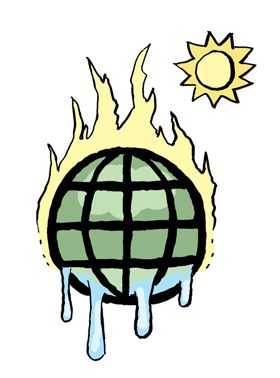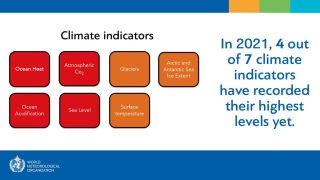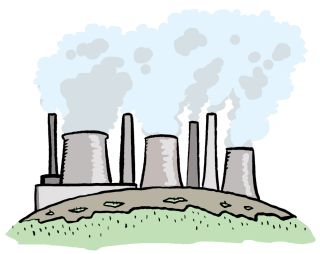Immediate investment in renewable energy key to mitigating worst impacts of climate change

Four key climate change indicators – greenhouse gas concentrations, sea level rise, ocean heat and ocean acidification – set new records in 2021 according to the World Meteorological Organisation ‘State of the Global Climate 2021’ report. Human activities are causing planetary scale changes on land, in the ocean, and in the atmosphere, with harmful and long-lasting ramifications for sustainable development and ecosystems. Extreme weather – the day-to-day “face” of climate change – led to hundreds of billions of dollars in economic losses and wreaked a heavy toll on human lives and well-being and triggered shocks for food and water security and displacement that have accentuated in 2022.

Main findings ‘State of the Global Climate 2021’
Greenhouse gas concentrations reached a new global high in 2020, when the concentration of carbon dioxide (CO2) reached 413.2 parts per million (ppm) globally, or 149% of the pre-industrial level. Greenhouse gas concentrations continued to increase in 2021 and early 2022.
The global annual mean temperature in 2021 was around 1.11 ±0.13 °C above the 1850-1900 pre-industrial average, less warm than some recent years owing to the temporary cooling effect of La Niña conditions at the start and end of the year. This did not reverse the overall trend of rising temperatures. The most recent seven years, 2015 to 2021, are the seven warmest years on record.
Ocean heat was at a record high in 2021. The upper 2000m depth of the ocean continued to warm in 2021 and it is expected that it will continue to warm in the future – a change which is irreversible on centennial to millennial time scales. Much of the ocean experienced at least one ‘strong’ marine heatwave at some point in 2021.
Ocean acidification. The ocean absorbs around 23% of the annual emissions of anthropogenic CO2 to the atmosphere. This reacts with seawater and leads to ocean acidification, which threatens organisms and ecosystem services, and hence food security, tourism and coastal protection. As the pH of the ocean decreases, its capacity to absorb CO2 from the atmosphere also declines.
Global mean sea level reached a new record high in 2021, after increasing at an average 4.5 mm per year over the period 2013 -2021. This is more than double the rate of between 1993 and 2002 and is mainly due to the accelerated loss of ice mass from the ice sheets. This has major implications for hundreds of millions of coastal dwellers and increases vulnerability to tropical cyclones.
Cryosphere: Although the glaciological year 2020-2021 saw less melting than in recent years, there is a clear trend towards an acceleration of mass loss on multi-decadal timescales. On average, the world’s reference glaciers have thinned by 33.5 meters (ice-equivalent) since 1950, with 76% of this thinning since 1980.
Flooding induced economic losses of US$17.7 billion in Henan province of China, and Western Europe experienced some of its most severe flooding on record in mid-July associated with economic losses in Germany exceeding US$20 billion. There was heavy loss of life.
Drought affected many parts of the world, including the Horn of Africa, Canada, the western United States, Iran, Afghanistan, Pakistan and Turkey. In sub-tropical South America, drought caused big agricultural losses and disrupted energy production and river transport. The drought in the Horn of Africa has intensified so far in 2022. Eastern Africa is facing the very real prospect that the rains will fail for a fourth consecutive season, placing Ethiopia, Kenya and Somalis into a drought of a length not experienced in the last 40 years.
Hurricane Ida was the most significant of the North Atlantic season, making landfall in Louisiana on 29 August, with economic losses in the United States estimated at US$75 billion.
The ozone hole over the Antarctic was unusually large and deep, reaching its maximum area of 24.8 million km2 (the size of Africa) as a result of a strong and stable polar vortex and colder than average conditions in the lower stratosphere.
Food security: The compounded effects of conflict, extreme weather events and economic shocks, further exacerbated by the COVID-19 pandemic, undermined decades of progress towards improving food security globally. Worsening humanitarian crises in 2021 have also led to a growing number of countries at risk of famine. Of the total number of undernourished people in 2020, more than half live in Asia (418 million) and a third in Africa (282 million).
Displacement: Hydrometeorological hazards continued to contribute to internal displacement. The countries with the highest numbers of displacements recorded as of October 2021 were China (more than 1.4 million), the Philippines (more than 386 000) and Viet Nam (more than 664 000).
Ecosystems: including terrestrial, freshwater, coastal and marine ecosystems – and the services they provide, are affected by the changing climate and some are more vulnerable than others. Some ecosystems are degrading at an unprecedented rate. For example, mountain ecosystems – the water towers of the world – are profoundly affected. Rising temperatures heighten the risk of irreversible loss of marine and coastal ecosystems. Between 20 and 90% of current coastal wetlands are at risk of being lost by the end of this century, depending on how fast sea levels rise. This will further compromise food provision, tourism, and coastal protection, among other ecosystem services.

The need to prioritise renewable energy transition
The World Meteorological Organisation and the United Nations have highlighted renewable energy transition as a means to transform our energy systems and move towards meeting global climate targets and the Paris Agreement. Five critical actions are required:
1. Make renewable energy technology an essential global public good
For renewable energy technology to be a global public good - meaning available to all, and not just to the wealthy - it will be essential to remove roadblocks to knowledge sharing and technological transfer, including intellectual property rights barriers. Essential technologies such as battery storage systems allow energy from renewables, like solar and wind, to be stored and released when people, communities and businesses need power. In order to support this there should be a new global coalition on battery storage led by governments and bringing together tech companies, manufacturers and financiers to fast-track innovation and deployment.
2. Improve global access to components and raw materials for renewable energy technologies
A robust supply of renewable energy components and raw materials is essential. More widespread access to all the key components and materials - from the minerals needed to produce wind turbines and electricity networks, to electric vehicles - will be key. Supply chains for renewable energy technology and raw materials are concentrated in a handful of countries, and more international coordination is needed to overcome this obstacle and to expand and diversify manufacturing capacity globally. Greater investments are needed to ensure a just transition - including in people’s skills training, research and innovation, and incentives to build supply chains through sustainable practices that protect ecosystems and cultures.
3. Level the playing field for renewable energy technologies by reforming fossil fuel bureaucracies
While global cooperation and coordination is critical, domestic policy frameworks must urgently be reformed to streamline and fast-track renewable energy projects and generate private sector investments.
Technology, capacity and funds for renewable energy transition exist, but there needs to be policies and processes in place to reduce market risk and enable and incentivise investments. To meet global renewable energy targets the share of renewables in global electricity generation must increase from 29 per cent (as it stands today) to 60 per cent by 2030. Clear and robust policies, transparent processes, public support and the availability of modern energy transmission systems are key to accelerating the uptake of wind and solar energy technologies Governments should fast-track and streamline approvals of solar and wind projects, modernize grids and set ambitious renewable energy targets that provide certainty to investors, developers, consumers and producers.
4. Shift energy subsidies from fossil fuels to renewable energy
Each year, governments around the world pour around half a trillion dollars into artificially lowering the price of fossil fuels - more than triple the subsidies given to renewables. Fossil-fuel subsidies are one of the biggest financial barriers hampering the world’s shift to renewable energy. The International Monetary Fund (IMF) says that about $5.9 trillion was spent on subsidizing the fossil fuel industry in 2020 alone, including through explicit subsidies, tax breaks, and health and environmental damages that were not priced into the cost of fossil fuels. That’s roughly $11 billion a day.
Fossil fuel subsidies are both inefficient and inequitable. Across developing countries, about half of the public resources spent to support fossil fuel consumption benefits the richest 20 percent of the population, according to the IMF.
Shifting subsidies from fossil fuels to renewable energy not only cuts emissions, it also contributes to the sustainable economic growth, job creation, better public health and more equality, particularly for the poor and most vulnerable communities around the world.
5. Triple investments in renewables
At least $4 trillion a year needs to be invested in renewable energy until 2030 – including investments in technology and infrastructure – to allow us to reach net-zero emissions by 2050. Not nearly as high as yearly fossil fuel subsidies, this investment will pay off. The reduction of pollution and climate impact alone could save the world up to $4.2 trillion per year by 2030.
The funding is there - what is needed is commitment and accountability, particularly from the global financial systems, including multilateral development banks and other public and private financial institutions, that must align their lending portfolios towards accelerating the renewable energy transition.
In the Secretary-General’s words, “renewables are the only path to real energy security, stable power prices and sustainable employment opportunities.”
Large scale investment in renewables must be a global and national priority. The impact of the war in Ukraine on global energy prices, and the rush to secure oil supplies risks locking in a high carbon future which would place climate goals at risk. Investment in renewable energy must be prioritised.

Social Justice Ireland position:
Social Justice Ireland has consistently called for a review of fossil fuel subsidies, for the elimination of those which are harmful to our environment and climate goals and that these resources be invested into renewable energy, upgrading the national grid and supporting a just transition.
The value of environmental subsidies in Ireland is substantial (€2.2bn in 2020). By ending environmentally damaging tax breaks and investing this money in people, communities and regions that will be most affected by climate adaptation, Government can help to ensure a Just Transition. It also increases the fiscal space available to government in terms of climate policy. Government can alleviate adverse climate change impacts by removing these subsidies rather than levying new environmental taxes or increasing the existing environmental tax rates/levels. This is something that must be considered in budgetary terms when implementing and designing climate policy.
In terms of overall public expenditure, systematic reviews should be carried out and published on the sustainability impacts and implications of all public subsidies and other relevant public expenditure and tax differentials. Subsidies which encourage activity that is damaging to natural, environmental and social resources should be abolished.
Eliminating harmful subsidies and investing in renewable energy and schemes to address energy poverty would put Ireland in a much better place to meet our energy targets. If Government is really serious about Ireland transitioning to a low carbon economy all subsidies for fossil fuels should be reviewed in 2022, with those which are harmful removed and the savings invested in renewable energy.